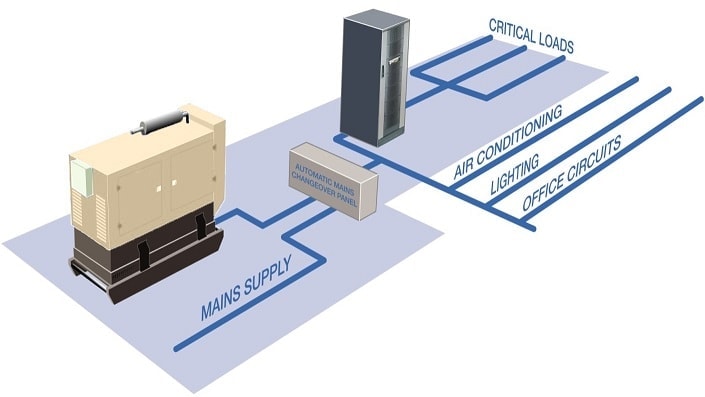Most people are aware that a UPS is a system that provides battery backup in the event of a mains failure. However UPSs protect sensitive onsite equipment from many other externally-generated electrical disturbance types as well. Authored by Matt Henley, technical services manager for KOHLER Uninterruptible Power, a KOHLER company, this article looks at why today’s critical loads are vulnerable, the type of electrical disturbances that threaten them and how UPS systems can offer protection.
Most people are aware that uninterruptible power supply (UPS) systems provide battery backup during a mains failure. However today’s critical loads require protection from mains disturbances as well as backup power during complete blackouts. The implications for UPS users can be revealed by looking at the nature of the critical loads, the type of electrical problems that can occur, and how UPS topology can provide the protection required.
Today’s critical loads
Loads are typically critical to their owning organisations’ viability when they involve processing, either of products or of data – and, in either case, processing involves computers. A data centre with its dense population of computer racks is an obvious example; however computers are also embedded within process control systems, medical equipment, communications hardware, ATM and EPOS terminals. As we shall see, no computer, whether it’s a chip buried within an EPOS terminal or a large standalone mainframe, can tolerate mains-borne disturbances. These can cause immediate damage to hardware, or perhaps more seriously, loss or corruption of data. This in turn can mean production loss, possible production equipment damage, inappropriate control system operation, lost business due to EPOS failure, and time lost during repair and reset of affected equipment.
Mains power problems
The most obvious failure mode is a complete blackout lasting several seconds, minutes or hours. Such situations clearly demand battery and possibly generator backup to maintain any continued activity. However even blackouts of just a few milliseconds can have devastating effects on both hardware and software, as the computers are denied the opportunity for an orderly shutdown. A sudden power loss can for example cause hard drive heads to crash onto and possibly scratch the platters, damage themselves and destroy data. Blackouts can arise from supply line faults, accidents, thunderstorms and other factors.
Spikes are short duration rapid voltage transitions superimposed onto the mains supply. Although short-lived, they can have large magnitude and therefore high energy. They can inflict both positive and negative voltage excursions, damaging and destroying electrical and electronic components. Software damage is also possible, which could extend as periodically read files may be corrupted and routine system processing compounds the errors. Spikes are most frequently and dramatically caused by locally grounded lightning strikes, particularly when induced into telecommunications cables. Other causes include thermostats or other equipment switching high electric currents, or load switching by the power companies.
Common mode electrical noise arises from electrical disturbances between the supply lines and earth. Normal mode noise comes from line-to-line and line-to-neutral disturbances and can be caused by lightning strikes, load switching, cable faults, nearby radio frequency equipment and other factors. High frequency noise energy entering the earth line can affect sensitive circuits that use the supply earth as reference for internal control logic. This type of interference can be mains-borne or induced through communications cables or other external connections. It can be minimised by fitting surge suppression filters to offending equipment and providing adequate cable screening and earthing.
Surges are voltage increases above the normal value that last for more than one cycle. They typically appear after a large load is switched off or following load switching at substations. Due to their relatively long duration, voltage surges can degrade a computer’s switched mode power supply components, leading to premature failure.
Conversely sags are drops in the mains supply that can last for several cycles. They are similar in generation to negative spikes, but have a much longer duration. They occur commonly, usually after switch-on of a large load such as air-conditioning equipment or rotating machinery. Sags can cause computers to switch off?
Harmonics are generally caused by non-linear loads drawing large peak currents from the mains. Well-known examples of such loads include controlled rectifiers, switched mode power supplies or rotating machines. These are typically found in computers, photocopiers, laser printers and variable-speed motors. Most PCs contain switch mode power supplies and the problems relating to harmonics build up progressively as the number of PCs on a site increases. In extreme cases the heat generated by the harmonics could destroy the site’s main neutral busbars unless they are significantly over-rated.
In general, harmonics cause a disproportionate rise in current, resulting in increased temperatures, component failure and general equipment overheating. A site with a large number of computers may require a UPS of low input current Total Harmonic Distortion (THD) – typically below 10%.
Brownouts are identical to sags but have a much longer duration and are generally more serious. They occur when the mains supply experiences excessive load demand and the generating company reduces the overall network voltage. Depending on the supply company’s response, a brownout can sometimes last for several hours.
Topology influences UPS protection capability
The two key UPS topologies in use today are known as On-line and Off-line systems, although variants on these also exist. Off-line systems are so called because during normal operation, when the mains supply is within acceptable limits, raw mains power is fed directly to the critical load, while also charging the UPS battery off line. The battery is ready to take over the critical load by driving an inverter if the mains supply fails. However, the inverter is not connected to the load during normal operation; it is only switched online if the UPS detects a mains problem.
This arrangement has two disadvantages making it unsuitable for the loads discussed. Firstly the critical load, connected directly to the raw mains during normal operation, is exposed to any of the mains disturbances described earlier. Although most off-line UPSs include a degree of spike suppression and radio-frequency filtering, the UPS itself plays no protective role. Secondly, because the UPS takes a small but finite time – typically between 2 and 10 ms – to switch in the inverter, the critical load sees a break in supply power. Although some systems can ride through this, this cannot be relied on.
By contrast an on-line UPS system comprises a rectifier/charger and inverter, connected in line between the mains supply and the load. During normal operation, the rectifier/charger float charges the UPS battery as well as supplying a stable DC voltage to the inverter. This means that the critical load enjoys processed power at all times. With the mains supply present, the rectifier, charger and inverter are all active. The rectifier and inverter act as a barrier to mains borne noise and transient voltage excursions, in addition to providing a well-regulated voltage output. If the mains supply fails, the inverter continues operating from battery power with no changeover delay involved. Within the battery autonomy, transfer to battery power is entirely invisible to the critical load.
Ofgem reports that on average a consumer suffers a blackout 0.82 times a year, or once every 445 days. This equates to a Mean Time Between Failures (MTBF) of about 10,000 hours. However as we have seen, critical loads can be unacceptably affected by incidents other than total blackouts, such as spikes, noise, surges and sags. If the definition of ‘failure’ is extended to include these events, the MTBF could in worst cases drop to 50 hours. Bearing in mind the possible consequences of power disturbances reaching the critical load, the protective part of a UPS’s role becomes readily apparent.



